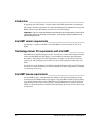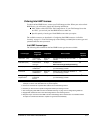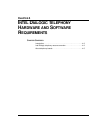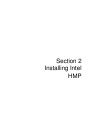
CHAPTER 4. INTEL DIALOGIC TELEPHONY HARDWARE AND SOFTWARE REQUIREMENTS 4-3
Trunk resources
Trunk resources connect the TeleVantage Server PC to trunk lines from your telephone service
provider. Intel Dialogic telephony boards provide trunk resources that support regular analog
trunks, analog DID trunks, Centrex/PBX trunks, T1 trunks, E1 trunks, and ISDN BRI trunks.
Station resources
Station resources connect the TeleVantage Server PC to analog CLASS or ADSI phones, digital
phones, and to other devices such as music-on-hold devices and paging systems. (The Toshiba
Strata CS-DKTU station board provides station resources to support Toshiba’s Strata DKT
digital phones.)
IP trunks and RTP resources
IP trunks support Voice-over-IP (VoIP) calls to SIP phones or other SIP devices, H.323 phones
or other H.323 devices, or to other TeleVantage Servers.
When determining how many IP trunks that you need to support your IP phone users, it may not
be necessary to have an IP trunk for each IP phone. The IP trunk will only be in use while the
user is actually on the phone (on a call, checking their voice mail, and so forth). If your IP phone
users are on the phone frequently—for example, if they are call center agents—then it may be
necessary to have a dedicated, 1-to-1 relationship between IP trunks and IP phones. However,
for most users, a lower ratio of IP trunks to IP phones—such as 1-to-4—may be acceptable.
Note:
An Excel spreadsheet called IntelRTPResourceNeeds.xls is provided for you to help
calculate the IP trunk and RTP Resource needs you need to support your configuration. It is
located by default in C:\Program Files\TeleVantage\Administrator.
Using a host-based VoIP stack
Most Internet telephony boards can be configured to use a host-based stack. (See the Trunk
Resources by Board table in Appendix E for boards that you can use with a host-based stack.)
When you add an Internet span in the TeleVantage Administrator and configure it with a
host-based VoIP stack, the IP protocol stack runs on the TeleVantage Server's CPU. Call control
goes over the PC's NIC and Real-time Transport Protocol (RTP) audio can go over the IP
telephony board's NIC if the board has a NIC. See “Using a host-based stack” in Chapter 5 of
Administering TeleVantage for more information.
IP trunks use RTP resources to provide an audio connection to other resources in the system
such as analog stations and digital trunks.
H.323 trunks have a fixed 1-to-1 mapping to RTP resources—you must assign an RTP
resource to each H.323 trunk via the TeleVantage Administrator.
SIP trunks allocate RTP resources from a shared pool. (RTP resources assigned to H.323
trunks are not available to SIP trunks.) When using the TeleVantage off-bus routing, SIP
trunks do not usually need RTP resources for SIP-to-SIP calls, so you may require fewer
RTP resources than SIP trunks.


















